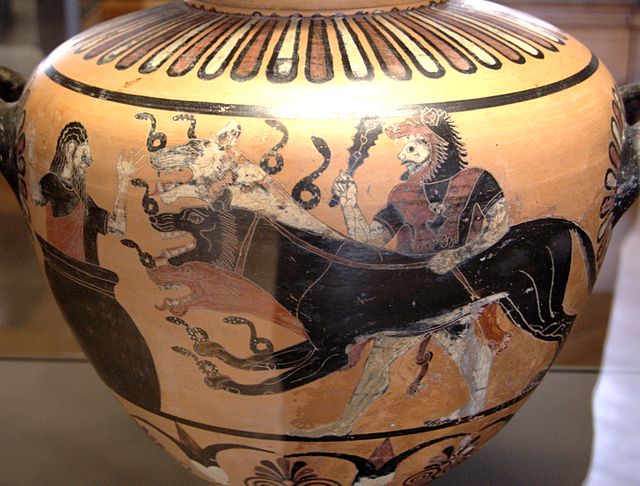A hellhound is a mythological hound that embodies a guardian or a servant of hell, the devil, or the underworld. Hellhounds occur in mythologies around the world, with the best-known examples being Cerberus from Greek mythology, Garmr from Norse mythology, the black dogs of English folklore, and the fairy hounds of Celtic mythology. Physical characteristics vary, but they are commonly black, anomalously overgrown, supernaturally strong, and often have red eyes or are accompanied by flames.
Hellhound
Goddess Hel and the hellhound Garmr by Johannes Gehrts, 1889
In Greek mythology, Cerberus, often referred to as the hound of Hades, is a multi-headed dog that guards the gates of the Underworld to prevent the dead from leaving. He was the offspring of the monsters Echidna and Typhon, and was usually described as having three heads, a serpent for a tail, and snakes protruding from his body. Cerberus is primarily known for his capture by Heracles, the last of Heracles' twelve labours.
Heracles, wearing his characteristic lion-skin, club in right hand, leash in left, presenting a three-headed Cerberus, snakes coiling from his snouts, necks and front paws, to a frightened Eurystheus hiding in a giant pot. Caeretan hydria (c. 530 BC) from Caere (Louvre E701).
Cerberus and Hades/Serapis. Heraklion Archaeological Museum, Crete, Greece.
Heracles, chain in left hand, his club laid aside, calms a two-headed Cerberus, which has a snake protruding from each of his heads, a mane down his necks and back, and a snake tail. Cerberus is emerging from a portico, which represents the palace of Hades in the underworld. Between them, a tree represents the sacred grove of Hades' wife Persephone. On the far left, Athena stands, left arm extended. Amphora (c. 525–510 BC) from Vulci (Louvre F204).
Athena, Heracles, and a two-headed Cerberus, with mane down his necks and back. Hermes (not shown in the photograph) stands to the left of Athena. An amphora (c. 575–525 BC) from Kameiros, Rhodes (Louvre A481).






